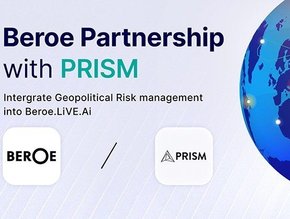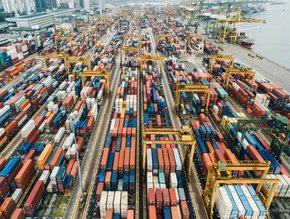Strategic decisions driven by smarter procurement analytics

Procurement functions of old once had a clearly defined mission: delivering cost savings in sourcing and purchasing. However, in today’s environment, procurement leaders have to navigate volatile markets with quick decision-making and contingency planning to maintain business continuity during disruption.
Chad Gottesman, Managing Director of the Sourcing and Procurement business at Accenture explains that in order to do this, procurement leaders need to have “real-time, predictive insights so procurement can effectively monitor supplier networks, watch markets and maintain continuity in the face of market volatility. By applying analytics to procurement, leaders are able to enhance decision-making and business strategy with a much faster turnaround time. In turn, this increases cost savings, lowers operating cost and reduces risk—all things that procurement leaders are keen on doing.”
What is data analytics?
“At Coupa when we think of data analytics, we think about it more broadly. We think about it from the perspective of community intelligence - a leveraged environment across our entire community. Community intelligence leverages data so that our fellow practitioners are better able to drive spend recommendations out of that analytics and insights to benchmark your own performance against that of the broader community. This will allow you to make critical business decisions based upon actual real-life data.”
Different types of analytics in procurement:
- Real-time pricing
- Supplier history and performance
- Benchmark spend and performance comparison (internally and externally)
Technology being used in procurement analytics:
- Artificial intelligence (AI)
- Robotics Process Automation (RPA)
- Machine Learning (ML)
- Michael Van Keulen, Chief Procurement Officer at Coupa Software
Why is it important for procurement leaders to adopt analytics?
Latest research from Accenture reveals that 90% of chief procurement officers (CPOs) believe their organisations are under extreme pressure to extend innovation. “This statistic would have been unheard of a decade ago,” says Gottesman. Accenture’s research further found that over 66% of procurement organisations struggle with lack of long term investments to transform processes and technology.
“As the data shows, leaders are struggling and need data analytics not only to deliver cost savings but drive additional value across the business. Procurement has a golden opportunity—one made possible by real-time data, predictive analytics and new tech tools—to double down on other key levers across direct and indirect spend like inventory and consumption of goods and services to lower spend and drive value,” adds Gottesman.
Alex Saric, CMO and smart procurement expert at Ivalua, adds to Gottesman comments, stating that “data analytics is the foundation for organisations looking to make strategic, informed decisions regarding how they spend and with which suppliers. By having access to data on everything from current trends to geo-political risk factors, organisations can identify new opportunities for innovation, monitor risk in particular areas of the market, and ensure compliance in relevant regulations for future projects.”
The impact of COVID-19
“Disruption caused by COVID-19 exposed blind spots for many organisations, as their insights were hampered by data that was dispersed and of poor quality, limiting effective decision making on suppliers when they needed it most. It’s now more important than ever that organisations have analytics capabilities that can bolster supply chain resilience and help to monitor risk, so they are better prepared for future crises.”
- Alex Saric, CMO and smart procurement expert at Ivalua

How can data be sourced in procurement functions?
Explaining that the sources for procurement data can come in the form of structured and unstructured data from diverse internal and external sources, Gottesman highlights that one of the key data sources for future-ready procurement operations is automated technologies that can be adjusted to demand needs. “This is an important way to reduce costs, and ranks as one of the critical factors in the digitisation of business processes,” says Gottesman. “Procurement leaders have reported impressive strides in automation with the percent of procurement executives reporting widespread or full-scale automation in their organisation having increased five times over the past three years.”
Another key procurement data source identified by Gottesman is “in AI and how businesses use the data coming from a specialised human-machine workforce to make decisions based on market consumption patterns, while reducing the workload required of employees.”
How does an organisation identify where they need analytics?
“We always hear from procurement officers that their organisations are under extreme pressure to extend innovation. They often struggle with long-term investments to transform processes and technology,” says Gottesman. Taking a top-down look at where procurement functions can be made more efficient, resilient and agile, procurement leaders should look at three key areas to drive value across their business: pricing, consumption, and inventory.
“Take how companies manage travel spend as an example. When business travel picks up again, procurement organisations will have to make complex travel spend decisions. They can negotiate rates with providers as always. But they can also look at demand and consumption in new ways. Collaboration tools will likely minimise trips and ridesharing provides a lower cost alternative to rental cars. Procurement analytics can play a huge role in making this process smarter and more efficient.”
What makes good procurement analytics?
Believing that businesses need to look at procurement differently, Gottesman explains that “at Accenture we believe that rather than looking at smaller changes to deliver savings, there needs to be a more holistic view. Data is a key partner in this expanded perspective and in building a future-ready organisation. Most companies still use intuition and experience to make business decisions but acting on real-time data will drive better outcomes.”
Gottesman further explains that just as important as diverse data and analytics, is “building ecosystem partnerships with suppliers to break through one of the greatest barriers to operating model transformation. Suppliers can protect a company from supplier-related risk that could damage its brand and finances, as well as from erosion of hard-won sourced benefits. Strong ecosystem partnerships can also play a key role in helping a company improve its supplier base to drive greater innovation and growth.”
Adding to Gottesman’s comments, Saric says that a unified approach to data analysis is critical. “Good data analytics requires trustworthy, actionable data to be available when and where it is needed in the procurement process, and a culture and process that reinforces data-based decision-making.”
“Bringing internal, third party and publicly available data together into a single platform, with a 360-degree view of each supplier and category will provide a complete view of what’s happening internally – as well as data on external risk factors and opportunities – allowing for better decision-making at every turn,” continues Saric.
Best practices for procurement leaders
“I firmly believe that procurement should lead a business spend management solution. It is really, really critical. Yes, we need to engage with other senior leaders such as the CFO, the CIO, and other cross-functional leaders. But what I often see is that practitioners let this decision be done or be led by other functional areas, such as finance, such as IT. So finance often thinks about AP automation to digitalise the finance process, while IT often thinks about it from an “I will plug something in within the existing ERP”, both of them theoretically make sense, but when it comes down to it it's a procurement decision, and procurement should lead end-to-end sourcing all the way down to settle. If you don't, you're going to leave value on the table and you're going to end up with a suboptimal outcome.
“So I really want to encourage procurement to lead business spend management solutions. It results in greater effectiveness, it reduces your risk, it gives you that real end-to-end visibility, and of course with the power of community intelligence you're going to continue to extract more value out of the spend that you manage.”
The benefits of procurement analytics
Chad Gottesman, Managing Director of the Sourcing and Procurement business at Accenture
“The value delivered is not only financial. Think of it as 360-degree value widening procurement’s sphere of influence and impact. There is value for the enterprise, stakeholders and the community—and across risk mitigation, sustainability, stakeholder experience, talent and inclusion and diversity. These breakthrough approaches are made possible thanks to the fundamentals of Closed loop spend management (CLSM), spend transformation and new ways of working.”
Michael Van Keulen, Chief Procurement Officer at Coupa Software
“If you have the right technology that has the right vision, the right end-to-end process, the right comprehensiveness that provides all your spending across departments, geographies, business units and functional areas. It puts not just procurement in a better position, but finance, the stakeholders, business leaders and functional leaders to make tough decisions and to make the right decision based upon the right data which allows you to better leverage your spend and apply real competitive pressure.”
The challenges of adopting procurement analytics
Chad Gottesman, Managing Director of the Sourcing and Procurement business at Accenture
- Procurement leaders continue to struggle to deploy more mature analytics capabilities and often don’t know what technology to invest in, with leaders believing they are lagging inoperational maturity and lack ‘future-readiness’ (only 7 per cent of leaders identify as future-ready)
- 24 per cent of procurement executives rate technology as a top challenge to growth in key areas
Alex Saric, CMO and smart procurement expert at Ivalua
- Data accessibility: to maintain effective supply chain visibility, organisations need access to a broad set of data, both externally and internally, and they need to trust it.
Data quality: internal data is often in poor shape at most organisations, spread out across many systems in inconsistent formats and not accessible by decision-makers.






